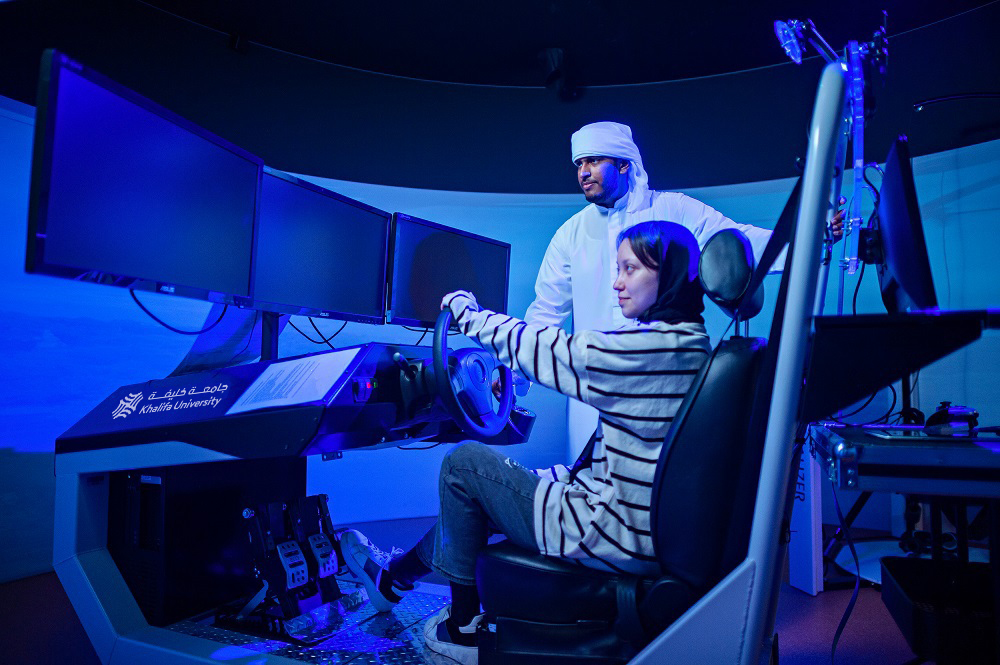Fear rewired: using VR to treat phobias
An innovative virtual reality therapy platform combines cutting-edge technologies and secure data to help patients face their deepest anxieties—and take control of their lives.
For most people, stepping into an elevator is nothing more than a quick ride to another floor. But for someone with claustrophobia, that intense fear of enclosed spaces can trigger overwhelming anxiety and panic. Recreating that level of psychological distress in a safe and controlled setting is a challenge that traditional therapy often struggles to meet.
Claustrophobia affects millions worldwide. Whether it’s set off by elevators, airplanes, crowded rooms or narrow stairwells, the condition can severely limit a person’s daily life. To address this, a research team at Khalifa University is developing an innovative exposure therapy that blends three cutting-edge technologies: the metaverse, blockchain and NFTs.
Facing fears in the metaverse
KU’s therapy is built around a “claustrophobia metaverse,” an immersive world where patients can safely confront their fears. Wearing a VR headset, they can choose from different triggers, such as the experience of lying in a virtual MRI scanner. “Our goal was to create an experience that is immersive, secure, and uniquely tailored to each patient,” explains Ahmad Musamih, the project’s lead researcher. “Claustrophobia is often triggered by very specific settings. The metaverse lets us recreate those environments with precision.”
“Claustrophobia is often triggered by very specific settings. The metaverse lets us recreate those environments with precision.”
Ahmad Musamih
But creating realistic virtual experience is only part of the challenge. Keeping patients’ records and therapy progress safe is just as important, especially when it comes to mental health. To protect such sensitive information, the team uses blockchain technology, a tamper-proof digital ledger which acts like an ultra-secure notebook that no one can erase or alter.
To guarantee this information is completely safe from manipulation, it’s uploaded to a secure network that splits the data into pieces and stores it across computers all over the world. This makes it much harder for hackers to find or delete. The team also strengthened the platform’s security by using a specialist code-analysis tool that detects vulnerabilities and fixes any digital loophole hackers could exploit.
“One of the biggest challenges in mental health is maintaining confidentiality without losing the ability to track progress,” says Khaled Salah, a member of the research team. “Blockchain solves this by recording milestones in an encrypted, permanent format. Personal details remain hidden, but patients, clinicians, and regulators can still verify the records.”

Digital rewards for real–world victories
Building on the secure foundation of blockchain, the therapy uses NFTs, unique digital keys to create a personalized experience. Each patient receives a private “entry pass”—that unlocks their personal therapy session in the metaverse.
As patients progress through their treatment, they earn a digital reward that serves as a meaningful record of their achievements in overcoming fear. “Patients feel a real sense of ownership and accomplishment, which encourages them to stay committed to their treatment,” explains Mohamed Seghier, a researcher on the team.
While advanced technologies power the therapy, the team stresses that its success depends on keeping patients’ needs at the center. “Beyond the technology, our focus is always on the patient,” notes team member Hamdan Hamdan. “By making therapy both engaging and secure, we aim to reduce stigma and make treatment more approachable for people who might otherwise avoid seeking help.”
Predicting effective and personalized treatment
The team plans to gather feedback from patients and mental health professionals to continuously refine and improve the therapy experience. Future enhancements may include AI-driven personalization and machine learning algorithms that predict which exercises will be most effective for each patient, as well as assess the risk of relapse.
Thanks to its flexible design, the therapy isn’t limited to claustrophobia alone. Virtual environments can be easily adapted to simulate a wide range of scenarios—open spaces for agoraphobia, tall buildings for acrophobia or crowded social settings for anxiety disorders.
This research supports the UAE’s vision to lead in technology and personalized healthcare, while contributing to the growing conversation around mental wellness. By combining advanced healthcare techniques with blockchain technology, the platform caters to a clientele accustomed to premium services and could become a major draw for high-end medical tourism.
“This research exemplifies the UAE’s commitment to technological leadership,” says researcher Mohammed Omar. “Applying blockchain and NFTs in mental health therapy is a game-changer, delivering unprecedented transparency, security and patient empowerment.”
Reference
Musamih, A., Salah, K., Jayaraman, R., Seghier, M., Hamdan, H., Ellaham, S., & Omar, M., Enhancing claustrophobia exposure therapy: A blockchain and NFT-enabled metaverse approach. Comput. Hum. Behav, 160, 108364, 2024. | Article




